Contents
- Early History
- Colonial History
- Local Figures & Organizations
- Chhatrapati Rajarshi Shahu Maharaj
- Early Institutions of Higher Learning
- Rajaram College
- Shri Maharani Tarabai Government College of Education
- Post-Independence Era and Contemporary Educational Infrastructure
- Primary & Secondary Education
- Institutions of Higher Learning
- Shree Mouni Vidyapeeth
- D .Y. Patil College Of Engineering & Technology
- DKTE Society’s Textile and Engineering Institute
- NGOs and Community-Based Education Efforts
- Sushila Koli and the Laximinagar Anganwadi Initiative
- Graphs
- Enrollment and Dropout Rate
- A. Student Enrollment Numbers
- B. Student Enrollment (Class-Wise)
- C. Student Enrollment (Gender-Wise)
- D. Student Enrollment (By School Management Type)
- E. Drop Out Rate (By Schooling Level)
- F. Drop Out Rate (By Gender)
- Schools
- A. No. of Schools
- B. No. of Schools (Filtered by Gender Mix)
- C. No. of Schools (By School Management Type)
- Teachers
- A. No. of Teachers
- B. No. of Teachers (By School Management Type)
- C. No. of Teachers (Male vs Female)
- D. Education Level of Teachers
- Sources
KOLHAPUR
Education
Last updated on 28 July 2025. Help us improve the information on this page by clicking on suggest edits or writing to us.
The educational framework of Kolhapur aligns with the broader structure of the Indian education system, encompassing pre-primary, primary, secondary, and higher education. However, its history extends well beyond this contemporary structure.
During the 19th century, the introduction of Western-style education brought significant changes. British administrators and Christian missionaries played a significant role in establishing schools and introducing curricula based on European models. Still, even as colonial influences grew, the early 20th century saw a wave of local initiatives; its existence indicated an increasing public awareness regarding the importance of education. Especially given that Kolhapur was a princely state, the conditions prevailing here were very different. The early 20th century saw a growing emphasis on local agency in education. Among the most significant contributors was Chhatrapati Rajarshi Shahu Maharaj, who implemented progressive reforms to expand access to education, particularly for marginalized communities. Later, local communities took charge of education, a movement that carried into the post-independence era, shaping the district’s educational landscape in lasting ways.
Early History
Kolhapur’s educational legacy stretches back to ancient times, when the region, known as Karvir, was a center for intellectual and spiritual learning. The rulers of Kolhapur were said to be strong patrons of education, particularly of the Sanskrit language and literature. It is said that ancient schools focused on Vedic studies flourished in the region, with subjects such as the Rigveda, Yajurveda, grammar, law, literature, poetry, medicine (Ayurveda), astronomy, and astrology being taught in Sanskrit.
Colonial History
The integration of Kolhapur into British administrative control in 1844 marked a new phase in the region’s educational development. The introduction of Western-style education began shortly thereafter. According to the colonial district Gazetteer (1886), the first state-supported schools were established in 1848 at Kolhapur, Panhala, Alta, and Shirol.
English education did not expand rapidly in this period. Local-language instruction remained prominent, and the presence of indigenous schools suggests that traditional systems continued to function even as new models were introduced. It is noted that, by 1854, the number of schools had increased to ten, enrolling 466 students. Only one of these institutions offered instruction in English, while the majority functioned in regional languages. Alongside these, a network of 122 local language schools also existed, educating 1,828 students.
In response to the expanding educational network, a teacher training school was established in Kolhapur in 1867 to improve instructional quality. By the 1870s and 1880s, efforts were being made to expand access. Night schools were introduced in 1871 to accommodate working people, especially labourers and artisans. By 1883, there were 19 such schools with about 750 students.
Female education also began to receive attention. In 1882, training classes for women teachers were introduced under the supervision of Miss Little. These classes prepared women to teach up to the seventh standard. By 1883, there were eight girls’ schools in the district with 500 girls enrolled.
The early 20th century saw continued support for traditional and modern forms of learning. The Shri Shahu Vedic School was established in 1903 and continued offering Sanskrit instruction into the later decades.
From the 1930s onward, a shift towards vocational education became more visible. Schools began to include manual and craft-based subjects such as spinning, weaving, carpentry, and agriculture. By 1952, three basic schools were set up based on this model, along with 28 craft schools, reflecting that there was an emphasis on self-sufficiency and livelihood skills. In 1942, a school for children with hearing and speech impairments was opened in Kolhapur. This marked an early effort toward making education more inclusive.
Local Figures & Organizations
As mentioned above, while entities from the West played a significant role in shaping the educational landscape of Kolhapur, local figures and organizations also emerged as key contributors. Many of them established institutions that continue to shape education in the district today, alongside community-led organizations that have played a lasting role in its development.
Chhatrapati Rajarshi Shahu Maharaj
Among these, Chhatrapati Rajarshi Shahu Maharaj stands out for his pioneering efforts to democratize education and challenge caste-based barriers.

Shahu Maharaj believed that education was essential for dismantling social inequality, particularly in addressing caste-based discrimination. His government supported the creation of boarding houses to accommodate students from marginalized communities, earning Kolhapur a reputation for fostering inclusive residential education. He famously remarked, "Just as the UK is the mother of Parliament, Kolhapur is the mother of Boarding Houses.”
Among his more radical interventions was the founding of the Shahu Vedic Vidyalaya in 1922. At a time when Vedic knowledge and religious ritual were largely restricted to Brahmin males, Shahu Maharaj sought to open access to all castes and even to women.
According to local accounts, the school emerged from an incident at the Panchganga River, where a Brahmin priest publicly questioned Shahu's right to participate in Vedic rituals due to caste. In response, Shahu established the Vidyalaya to challenge caste monopoly over religious learning.
Despite opposition, including a legal challenge by Brahmin groups, the British administration upheld Shahu’s right to open the school. The institution remains operational today, offering a three-year Vedic course to around 25 to 30 students annually, continuing its legacy of inclusive religious education.
Shahu Maharaj also emphasized literacy through support for public libraries. The Karveer Nagar Vachan Mandir, originally known as the Kolhapur Native Library, emerged as a significant center for public learning. Established during the reign of Shivaji III (Babasaheb Maharaj), it was developed through the efforts of Colonel H.L. Anderson, who rallied community support for its founding. Residents collectively contributed ₹5,000, reflecting strong public investment in educational infrastructure.

Beginning with a modest collection of 442 books, the library expanded significantly under Shahu’s patronage. He is remembered locally as its “first supporter.” Today, the Vachan Mandir holds over 70,000 volumes and continues to serve as a major educational and cultural institution for Kolhapur and the surrounding region.
Early Institutions of Higher Learning
The period also witnessed the establishment of several institutions of higher learning in Kolhapur, a notable development given that, as recorded in various district gazetteers (in Maharashtra), indicating that such a focus on higher education was relatively uncommon across much of Maharashtra at the time.
Rajaram College
Founded in 1880, Rajaram College is the oldest institution of higher education in the Kolhapur district and among the earliest in the region.
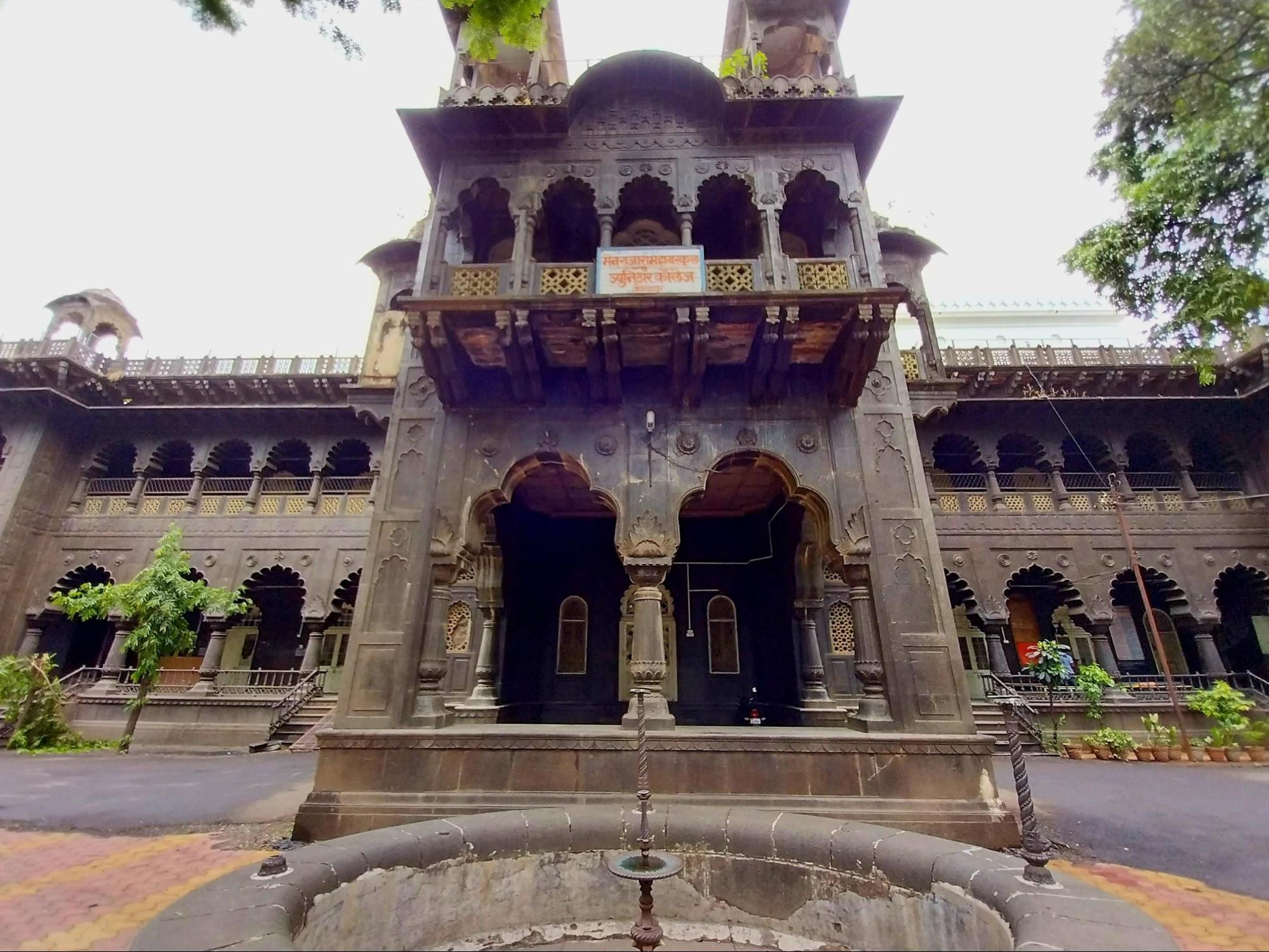
The college was originally conceived as Rajaram High School, an initiative of Chhatrapati Rajaram Maharaj of Kolhapur, who proposed its founding through a communication to the then British political agent, Colonel H.L. Anderson. The construction of its iconic building was completed by 1870, and the college officially opened a decade later near what is now Vidyanagar.
Rajaram College became a center for academic advancement and public education. In 1871, the Rajaram Scholarships were introduced to support students from economically disadvantaged backgrounds. These scholarships, funded by a public subscription of ₹21,000, were instituted in memory of Rajaram Maharaj. According to the colonial district Gazetteer (1886), they were intended to assist meritorious students studying in local schools.
To further expand opportunities, the college offered ten scholarships through the Peta and Sansthan Exhibitions, aimed specifically at encouraging students from rural areas to pursue higher education. An additional initiative, the Poor Boys Fund, established in 1869, provided support for essential educational expenses, such as textbooks, ensuring that financial constraints would not become an obstacle for students.
Today, Rajaram College continues its long-standing tradition of promoting accessible education and supporting rural and underprivileged students through various scholarship schemes.
Shri Maharani Tarabai Government College of Education
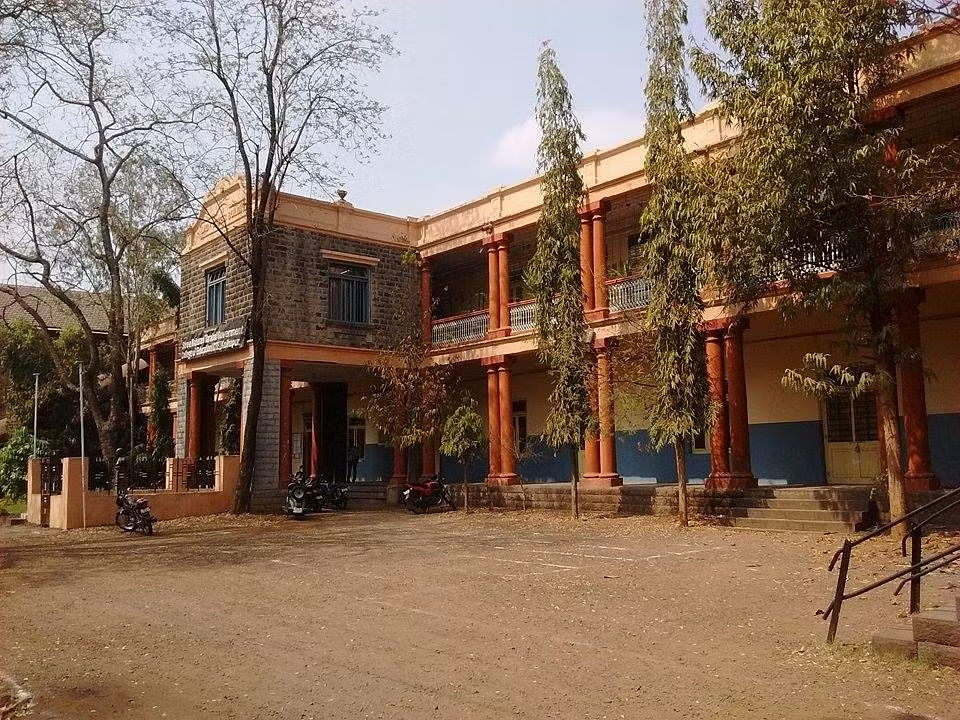
Founded in 1934, Shri Maharani Tarabai Government College of Education is said to be the first higher learning institution in Southern Maharashtra that is dedicated to teacher education. The college is recognized by the National Council for Teacher Education (NCTE) and is permanently affiliated with Shivaji University, Kolhapur. It has a long history of training educators and contributing to the development of the teaching profession in the region.
Post-Independence Era and Contemporary Educational Infrastructure
Following India's independence, the education system in the district underwent major transformations, driven by both state policies and local leadership. The introduction of structured education levels, pre-primary, primary, secondary, and higher education, along with the implementation of National Education Policies, heavily shaped Kolhapur’s educational landscape. Over the years, the sector expanded with contributions from both government-funded institutions and private organizations. Additionally, the introduction of various educational boards, each offering distinct curricula and standards, provided students with more choices and opportunities.
Primary & Secondary Education
During the colonial period, both public and private efforts in education primarily focused on primary and secondary schooling, as indicated by data from district gazetteers across Maharashtra. While basic infrastructure for primary and secondary education existed, its expansion was closely tied to increasing enrollment and greater involvement of local figures.
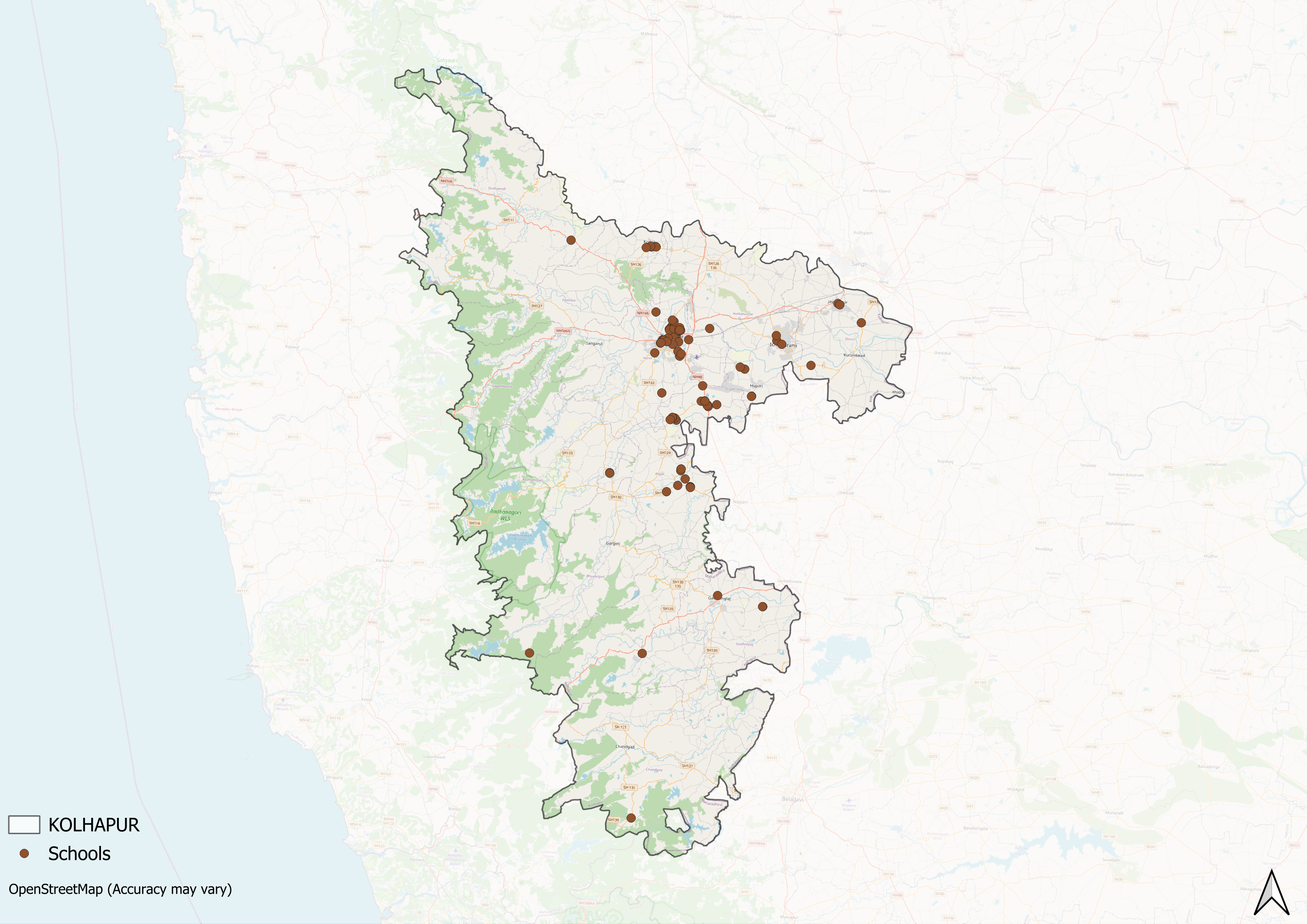
Today, this expansion is evident in the widespread presence of schools across various wards of Kolhapur, with available data reflecting the steady growth of educational institutions in both urban and rural parts of the district.
Over time, institutions affiliated with various educational boards also emerged. According to local sources, the majority of primary, secondary, and higher secondary schools in Kolhapur district follow the State Secondary Certificate (SSC) board. In rural talukas such as Shahuwadi, Gaganbawda, and Shirol, English-medium schools remain limited, and options under boards like CBSE and ICSE are largely inaccessible for many families.
Even in Karvir tehsil, where the district headquarters is located, only a small number of schools offer CBSE and ICSE curricula, and examples cited by residents include Vibgyor, Shantiniketan, the Sanjay Ghodawat Group of Schools, RSEMS, and Seventh Day School.
Institutions of Higher Learning
Higher education in Kolhapur expanded significantly in the post-independence period through the efforts of local rulers, reformers, and educationists. Many institutions in the district today are privately managed, semi-private, or autonomous.
Shree Mouni Vidyapeeth
Shree Mouni Vidyapeeth, located in Kolhapur, originated from the Gargoti School founded under the guidance of Chhatrapati Shahu Maharaj. It later evolved into a rural university focused on the dual goals of education and rural development. Established in 1952, the Vidyapeeth adopted the motto "Rural Reconstruction Through Education and Education Through Rural Reconstruction," reflecting its mission to integrate community development with formal education.
The institution drew inspiration from the 1948 Radhakrishnan Commission, which recommended the establishment of rural universities. It was founded by Dr. V.T. Patil and Padmashri Dr. J.P. Naik, both of whom were committed to inclusive and community-oriented education.
Established on 18 November 1962, Shivaji University in Kolhapur plays a central role in the region's higher education system. Inaugurated by Dr. Sarvepalli Radhakrishnan, then President of India, the university was founded to address the educational needs of the districts of Kolhapur, Sangli, and Satara, and has since grown into a vital institution for South Maharashtra.

The university administers a wide range of academic programs and is affiliated with numerous colleges in the region. Among its key initiatives is the Shivaji University Merit Scholarship, which awards 500 annual scholarships to academically meritorious students from affiliated colleges, enabling continued access to higher education.
In a pioneering move, Shivaji University was the first in India to introduce research fellowships for Ph.D. students enrolled in its postgraduate departments. These fellowships, supported by an annual allocation of around ₹45 lakh, aim to promote advanced research and academic inquiry.
D .Y. Patil College Of Engineering & Technology
Founded in 1984, D. Y. Patil College of Engineering & Technology is an autonomous, self-financed institution in Kolhapur. It forms part of the D.Y. Patil educational network initiated by Padmashree Dr. D. Y. Patil, a former governor of Tripura, Bihar, and West Bengal.
Granted autonomous status in 2020 by the UGC and Shivaji University, the college is NAAC-accredited with an 'A' grade. Its Architecture Department ranks among the top in India, featuring in lists by Outlook India and India Today in 2021.
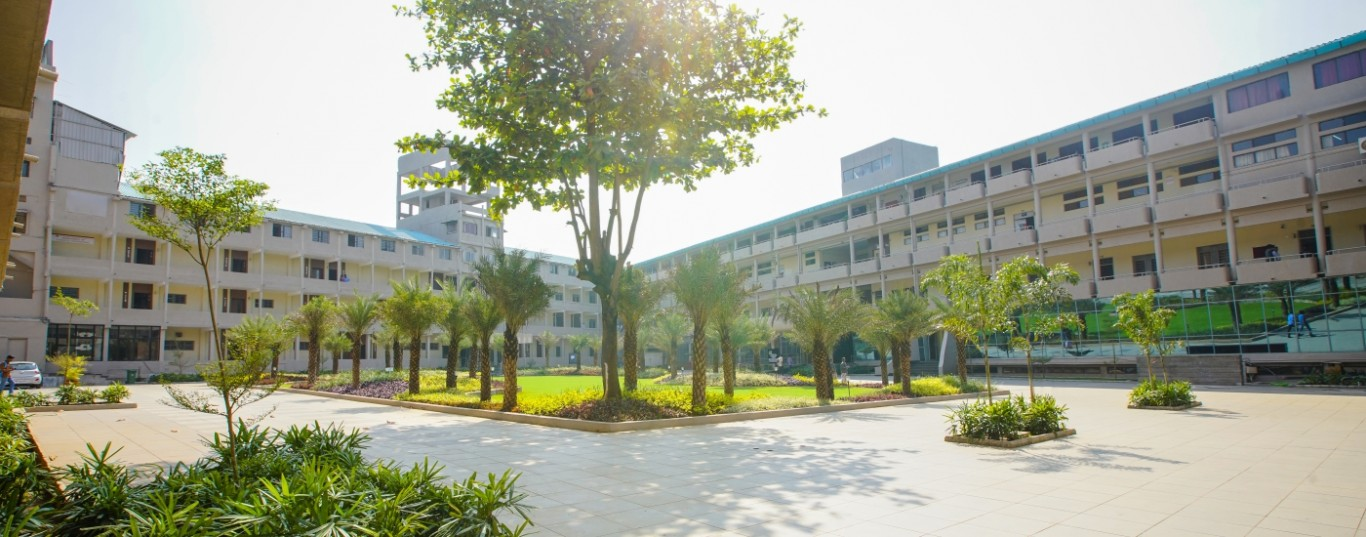
DKTE Society’s Textile and Engineering Institute
The DKTE Society’s Textile and Engineering Institute, located in Ichalkaranji, is a premier institution specializing in textile education and engineering. Established in 1982 by a consortium of local industrialists and educationists, the institute was founded to support the textile industry through skilled human resource development and technological innovation. It is one of the earliest self-financed engineering institutes in Maharashtra and has played a pivotal role in shaping the textile and engineering workforce of the region.

DKTE offers undergraduate, postgraduate, and doctoral programs in various branches of engineering, with a particular emphasis on textile technology, textile engineering, fashion technology, and mechanical and electronics engineering. The institute is known for integrating hands-on industrial training with classroom instruction, preparing students for both technical and managerial roles in industry.
It maintains strong academic and research partnerships with international companies such as RIETER and Uster Technologies (Switzerland), Asahi Kasei (Japan), and ITEMA (Italy). These collaborations contribute to cutting-edge research, internships, curriculum development, and technology transfer.
DKTE has twice received the ‘Best Industry-Linked Engineering Institute’ award from the AICTE and CII, a recognition of its strong ties with the manufacturing and textile sectors. During the COVID-19 pandemic, the institute actively supported the local community by offering hostel facilities for use as a COVID Care Centre and collaborating with garment manufacturers to produce face masks.
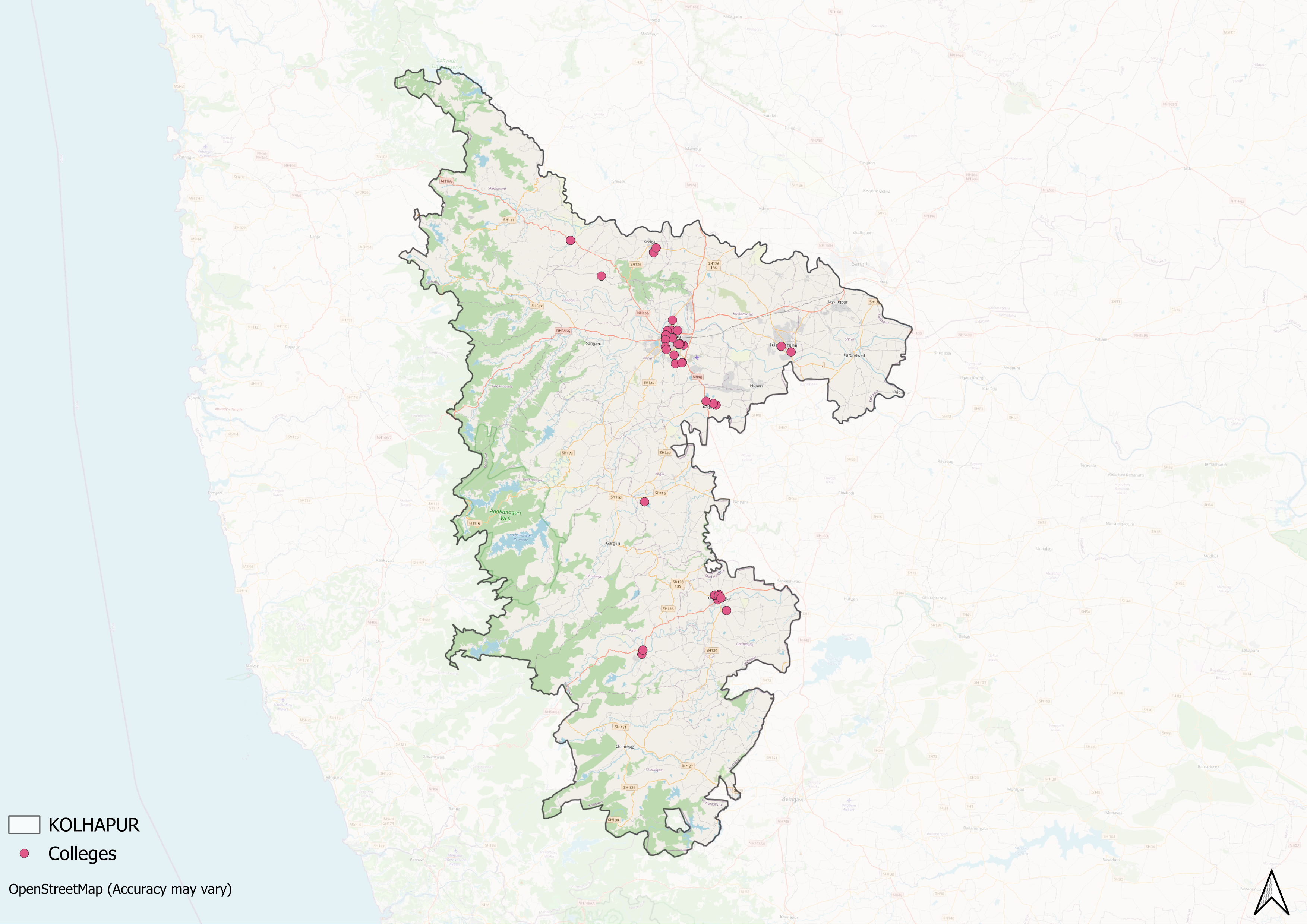
NGOs and Community-Based Education Efforts
Education has been a key driver of social reform, particularly in addressing inequality and expanding access to learning. While formal institutions provide structured education, many communities continue to face barriers due to poverty, social stigma, or lack of resources. To address these challenges, various organizations in Kolhapur have focused on community-based education initiatives, with each working to tackle specific social challenges present in the district.
Sushila Koli and the Laximinagar Anganwadi Initiative
Over the years, there have been significant strides in the expansion of education in India, particularly in rural regions. However, challenges persist in terms of access, reach, and attitudes towards education. While large governmental initiatives and organizations have played key roles in addressing these issues, it is also the grassroots efforts of local individuals and communities that have made a significant difference in ensuring educational access in their localities.
In many rural areas of Kolhapur district, limited access to formal education, especially for children from low-income families, has remained a significant challenge. One such effort was led by Sushila Koli in Laxminagar Basti, a village in Kolhapur district that lacked early childhood education facilities in the early 1990s. In 1991, observing the absence of an Anganwadi and the tendency for children to assist in agricultural work rather than attend school, Koli started a pre-school from her own home. The aim was to offer foundational literacy and numeracy to children who had no access to early education.
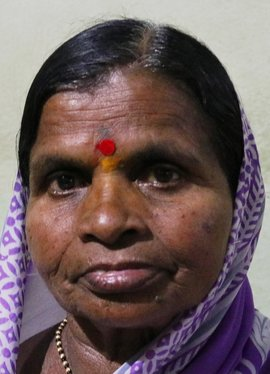
At the time, many parents were reluctant to send their children to school, prioritizing immediate contributions to household income over long-term learning. To address this, Koli went door to door, speaking with families about the value of education. Her persistence gradually built community trust, and more children began attending the informal centre.
Despite receiving no institutional support, Koli continued the initiative using her own resources. She did not charge fees, relying instead on occasional food grain contributions from families. Over time, as enrollment grew, the community’s attitude towards early education also began to shift.
According to a Better India article (2018), Koli educated more than 250 children over the span of eleven years. In 2003–04, her Anganwadi was formally recognised and converted into a government-supported school, Balwadi Vidya Mandir. This marked a transition from an informal, home-based effort to a permanent part of the local education system.
Graphs
Enrollment and Dropout Rate
Schools
Teachers
Sources
CP Umesh. 2005. “Chapter II: Kolhapur City, A Profile.” Shivaji University Institutional Repository.
D.Y. Patil Group. “About D.Y. Patil Group.”D.Y. Patilhttps://coek.dypgroup.edu.in/about-dyp-group/https://coek.dypgroup.edu.in/about-dyp-group/
DKTE Society’s Textile and Engineering Institute. “About DKTE.” DKTE Society’s Textile and Engineering Institute.https://www.dkte.ac.in/
Gazetteers of Bombay Presidency. 1886 (Reprinted in 1999). Kolhapur District. Gazetteer Department, Government of Maharashtra, Mumbai.
Guest Contributer. 2018. “For 11 Years, This Inspiring Woman Taught 250 Rural Kids for Free!” The Better India.https://thebetterindia.com/128500/sushila-ko…
Higher Education Digest. 2020. “DKTE Society’s Textile and Engineering Institute: Nurturing Learners with Relevant and Contemporary Technical Education.” Higher Education Digest.https://www.highereducationdigest.com/dkte-s…
Karmaveer Hire Arts, Science, Commerce & Education College. About Mouni Vidyapeeth.” Karmaveer Hire Arts, Science, Commerce & Education College.https://www.khcollege.ac.in/about-us/about-m…
Maharashtra State Gazetteers. 1960. Kolhapur District. Directorate of Government Printing, Stationary & Publications, Government of Maharashtra, Mumbai.
Shivaji University. “About Shivaji University.” Shivaji university.https://www.unishivaji.ac.in/about_suk/about…
SMT College. “College Profile.” SMT College.http://smtckop.edu.in/bt/Collegeprofile.aspx
Last updated on 28 July 2025. Help us improve the information on this page by clicking on suggest edits or writing to us.